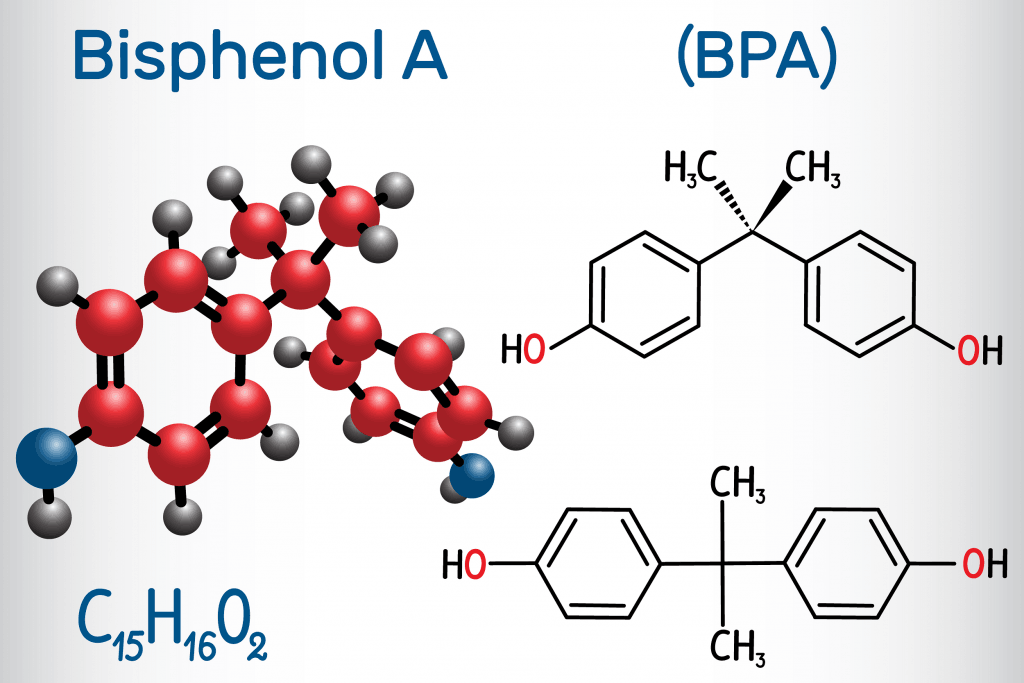Bisphenol A is a compound used for the production of plastics. Most commonly found in plastic products made of polycarbonate, thermal paper for fiscal printers and as a coating inside cans. BPA has a structure similar to the female sex hormone - estrogen, therefore it can affect the functioning of the endocrine system. According to reliable scientific studies, bisphenol adversely affects many health aspects.
Bisphenol A (BPA) is a chemical compound from the group of phenols that are used for the production of plastics. It was synthesised for the first time in 1891 by the Russian chemist Alexander Dianin. The production of BPA, which is a component mainly of polycarbonates and epoxy resins, has grown gradually with the increasingly common displacement of glass, ceramic or wood packaging by packaging from synthetic materials.
In 1970, 45 million kilograms of bisphenol A was produced worldwide, while in 2004 - 3 billion kilograms. BPA is contained in bottles and another plastic packaging for food, various types of products made of plastic, e.g.
Bisphenol A (BPA) - What is it?
BPA is poorly soluble in water. It also shows good solubility in food products containing fat and sugar. Its structure resembles the female sex hormone - estrogen, hence it can connect with estrogen receptors in the body and thus affect the functioning of the hormonal economy.
Bisphenol A is a very controversial compound that can affect the body negatively. Infants and young children are particularly vulnerable to its toxic effects because their organisms cannot effectively inactivate and excrete toxins.
The concentration of bisphenol A in the urine of people subjected to a large cross-sectional study increased threefold in about 15 years (results from the late 1980s and 1990s compared with the beginning of the 21st century were compared). This is a consequence of the more frequent contact of people with BPA and its penetration into the body from various sources.

Currently, the use of bisphenol A is prohibited in Korea, Japan, Canada and some US states. The interest in BPA and the emphasis on recognizing this compound as a toxic substance increased in 2010 when the results of a 4-year study showing that 91% of the Canadian population has significant amount BPA in the organism were published. In 2011, the European Union banned the use of BPA in the production of bottles for toddlers.
However, the compound was not completely banned in the production of plastics or even food packaging. The safe daily BPA dose, which is currently 0.05 mg/kg body weight, has not been reduced. Individual European Union countries impose restrictions on the use of bisphenol A. These include France and Sweden. No legal restrictions on BPA have been introduced in Poland yet.
Bisphenol A (BPA) - in bottles and more. BPA sources
Currently, when synthetic materials from BPA are so common, it is impossible to completely eliminate this compound from the body.
This is confirmed by an experiment conducted at the University of Illinois in Chicago, during which subjects for a month avoided using items containing bisphenol A.
It turned out that BPA was detected in the urine of the study participants, which means that they had been in contact with the compound in the last 48 hours. However, contact with bisphenol A can be minimized.
Bisphenol A (BPA) - effect on health
There is more and more scientific evidence showing the adverse effects of bisphenol A on humans. BPA is a compound that affects the functioning of the endocrine system, and its harmfulness in many aspects has been confirmed in studies on laboratory animals, as well as on humans. It turns out that BPA affects, among others fertility, metabolic diseases and impairs normal development in childhood.
Type II diabetes
The relationship between type II diabetes and high exposure to bisphenol A has been demonstrated in many human studies. Based on the cross-sectional American NHANES study, which is one of the largest and most reliable, it was found that elevated BPA in urine is associated with an increased risk of developing type II diabetes.
The assessment took into account indicators such as fasting glucose, postprandial glucose, glycosylated haemoglobin, and the use of drugs that lower blood sugar and insulin. The relationship between BPA has been demonstrated both for people with normal body weight, as well as those who are overweight and obese, as well as for non-smokers and smokers.
Similar conclusions have been drawn from most studies conducted in Asia. At the same time, it should be mentioned that there are studies conducted in large groups in which there was no correlation between high BPA concentration in urine and the risk of type II diabetes.
Obesity
The relationship between bisphenol A exposure and obesity are one of the most common problems raised in the research. Most large cross-sectional studies have shown a link between increased BPA exposure and obesity, high BMI and waist circumference, suggesting that this relationship promotes the accumulation of abdominal fat, which increases the risk of many diseases, including metabolic ones.
Analyzing studies in adults over 20 years of age, it was found that high BPA concentration in urine was associated with obesity only in Caucasian people. Studies on children and adolescents also point to the association of excess body fat with BPA exposure. At the same time, these relationships are much stronger for younger children up to 11-12 years old.
Cardiovascular disease
The conclusions are drawn large studies clearly suggest a close relationship between high BPA in urine and heart disease, e.g. myocardial infarction, shortness of breath, ischemic heart disease.
In connection with BPA exposure, a higher frequency of hypertension and reduced heart rate variability were found in adults - a factor responsible for the adaptation of heart rate to the body's need for blood and oxygen.
It was also noted that people with moderate to severe coronary artery disease had significantly higher BPA levels in urine than study participants in the control group. This was confirmed during nearly 11 years of observation of participants aged 40-74.
Fertility
High urinary BPA levels are associated with the lower ovarian activity, fewer maturing eggs, and lower hormones to get pregnant. BPA also reduces male fertility and has a negative effect on sperm quality. Fertility research has one big disadvantage - it is conducted on a small group, so it is difficult to draw conclusions for the entire population.









